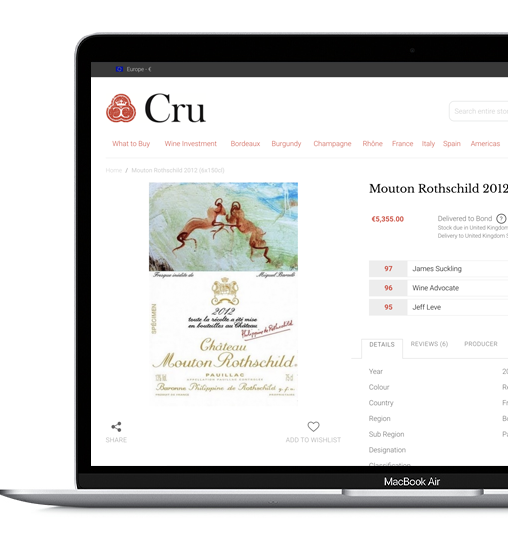Spain - All Red Wines
One of the most famous vineyards for red wines in Spain is Vega Sicilia, located in Ribera del Duero. Their flagship wine, Vega Sicilia Único, is a legendary red that exemplifies the region's mastery in crafting age-worthy and complex wines. With its deep color, intense aromatics, and a harmonious blend of Tempranillo and other varietals, Vega Sicilia Único has become an iconic representation of Spanish winemaking.
In Priorat, Clos Mogador is celebrated for its exceptional red wines. Their Clos Mogador, crafted from a blend of Grenache, Carignan, and other local varieties, showcases the rugged landscape of the region with its concentrated flavors, firm tannins, and remarkable aging potential.Moving to the region of Bierzo, Descendientes de Jose Palacios is a notable vineyard known for its Mencía-based red wines. Their Petalos del Bierzo is a stellar example of the region's winemaking excellence, offering vibrant fruit flavors, floral aromatics, and a lively acidity that epitomizes the elegance of Bierzo's red wines.
Spain's fine red wines beautifully reflect the country's winemaking diversity, from the bold and structured reds of Ribera del Duero and Rioja to the powerful and mineral-driven wines of Priorat and the elegant and aromatic expressions of Bierzo. With their depth, complexity, and the legacy of Spain's winemaking heritage, these red wines embody the essence of Spain's vibrant wine culture. Spanish red wines promise a journey of flavors that capture the essence of this captivating wine country.
Spain - All Red Wines


-
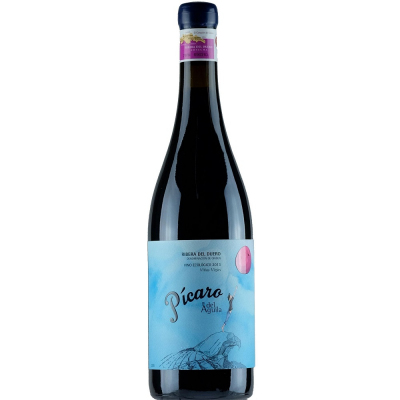
Wine Advocate (94+)
The youngest of the reds I tasted, the 2019 Pícaro del Águila Tinto is their most approachable red and is still serious, vibrant and aromatic with great length and still has good aging potential. They use the grapes from the warmest vineyards they have in the village of La Aguilera, form the northern part closer to La Horra, mostly Tempranillo but with some 5% of other varieties (red and white) interplanted in the old vineyards, fermented together with full clusters and indigenous yeasts and matured in French oak barrels for 15 months. Like the 2019 Clarete, this is young and tender and has more tension than I expected for a warmer year. It has less oak than previous years (only 10% or 15% new barrels), and the wine feels better balanced and is floral and aromatic. It's medium-bodied with a very fine texture, a pretty wine that drinks very well and doesn't reflect a warm year at all, as it has incredible freshness. A great Pícaro. They produced 69,852 bottles and 850 magnums, a notable increase in volume... while they increase the quality! It was bottled in February 2021.Inc. TAX€386.77 -
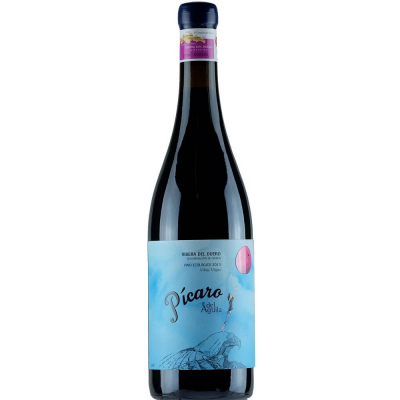
Wine Advocate (95)
The juicy, velvety and aromatic red 2020 Pícaro del Águila Tinto is fine-boned and quite faithfully represents what they want to express with this cuvée; it's very tasty and has some chalkiness (perhaps through less ripeness than in years like 2018) with 14% alcohol and mellow acidity. The nose reveals some Côte-Rôtie-like notes of smoked meat and violets. 2020 delivered a good crop of healthy grapes that produced the finest wine to date for this bottling. This is superb, elegant and powerful, with everything in place (seems to be the signature of 2020) and perfectly integrated oak. 71,382 bottles and 1,979 magnums produced. It was bottled in September 2021.Inc. TAX€435.97 -
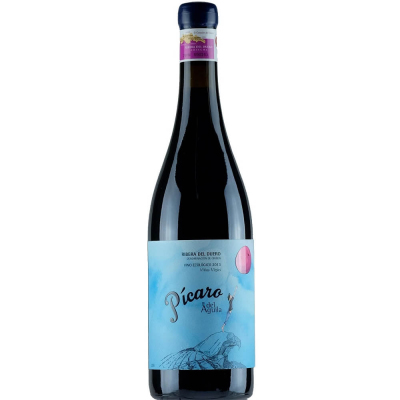 Inc. TAX€388.04
Inc. TAX€388.04 -
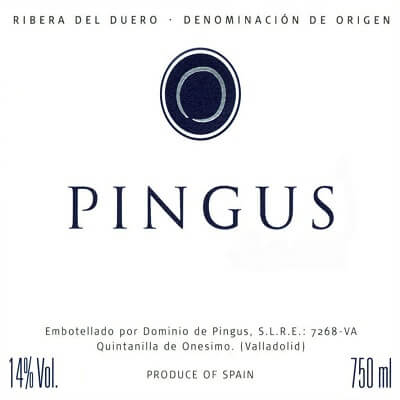
Vinous (95)
Deep, bright ruby-red. Cherry, licorice and smoked meat at the outset; then exploded with raspberry fruit. Lush, smooth and silky, with lovely inner-mouth perfume. Highly complex flavors of raspberry, minerals, bitter chocolate and smoky oak convey an extraordinary sweetness without any excess weight. Expands wonderfully on the extremely long, aromatic finish, which features noble, palate-dusting tannins. From the recorked bottle, the wine again began with dominant smoky, tarry torrefaction notes, and within minutes was taken over by red berries and flowers. More classic than the '03, but the 2003 may be even richer.Inc. TAX€4,361.98 -
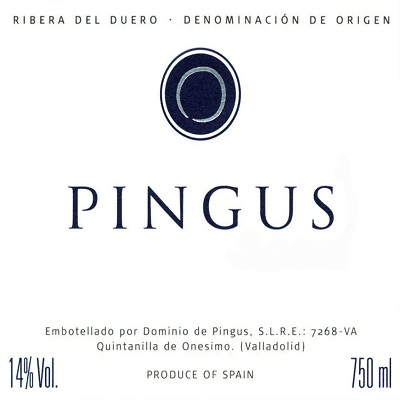
Wine Advocate (98)
The 2006 Pingus is a spectacular effort. A glass-staining saturated opaque purple, it delivers an other-worldly perfume of smoke, lavender, mineral, scorched earth, and an amalgam of kinky black fruits. Voluptuous on the palate in a measured way, it has superb balance, layered, complex flavors, ripe tannin that is entirely covered by the fruit, and a decade of aging potential. This monumental wine will evolve effortlessly for 10-15 years and offer a drinking window extending from 2016 to 2036.Inc. TAX€11,653.52 -
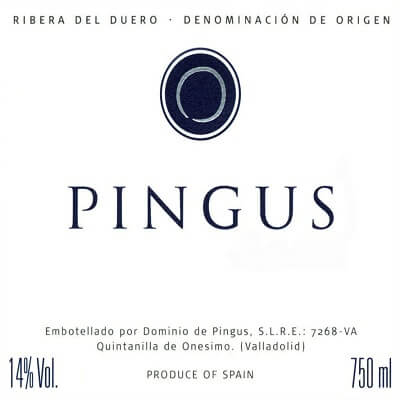
Wine Advocate (96)
I tasted the 2013 Pingus one week before the wine was to be bottled, but one never knows. I tasted the 2012 under the same circumstances last year, and after my tasting, Peter Sisseck decided the wine needed some more time, so the élevage was extended and the bottling delayed. I was told this should be very close to the bottled version. The nose is aromatic, expressive and open, quite perfumed and subtle, with no traces of oak (the wine now ages in used barriques); even the spices are very much in the background. The Pingus vineyards behaved quite well in a difficult vintage, as great vineyards are a lot more homogeneous, so the vines are very balanced: the two vineyards used for Pingus, San Cristobal and Barroso, were planted in 1929 with two different massale selections. The palate is also approachable and gentle, with very good acidity and very fine tannins, elegance and character. I think there will be very few (or none!) wines in Ribera in 2013 like this Pingus. Well done! Three weeks later, I received an email letting me know that the wine had been bottled, so I proceeded to taste the bottle version, which showed what the sample promised. 2013 will be a vintage, that in Ribera del Duero, will show the differences of the work in the vineyards and what they do at Pingus clearly paid off. Even after the recent operation, the wine is harmonious and feels very balanced; there is no dizziness and it keeps the poise. A real triumph for the vintage. 6,600 bottles were filled at the end of July 2015.Inc. TAX€1,747.45 -

Wine Advocate (100)
I don't think I've ever tasted a wine more recently bottled than the 2014 Pingus, which was bottled in the morning and I tasted it that very same evening! Peter Sisseck compares this to the 1995, the first vintage ever produced, when he learned that when you have such perfect grapes, you should do very little to the wine. He's been trying to replicate that first vintage, but there's nothing you can do to force it, as it has to be the natural conditions of the vintage that bring those grapes. What he also learned with the 1995 was that with wines like that, you need a long and slow aging in oak; so for the 2014, he decided to do a little longer élevage—three winters in barrel—but in 100% used barrels, something he started in 2012. If it would have been new oak, as in the past, it would have been impossible to have such extended aging without marking the wine too much and possibly forever. The wine was quite tannic to start with, but it was racked every six months, and in that way they have managed to tame those tannins without getting the wine tired, as the aging itself was quite reductive. The nose is quite harmonious and open, but maybe not very expressive, a normal thing considering the extremely short bottle age it had (hours!), but it should gain precision in bottle. In instances like this, you have to guide yourself by the palate. And it's precisely on the palate where you find that texture that is almost unique to Ribera del Duero when it's as perfect as this. It's very different from other zones, a velvety mouthfeel and a surrounding sensation of comfort, incredibly long. The tannins are ultra fine and with that subtle chalkiness of the limestone soils, which also added to the tastiness and the supple aftertaste. In short, I cannot think of a way of improving this Pingus other, than getting a magnum instead of a regular bottle! Congratulations, Peter Sisseck! 4,800 bottles were filled on January 16th of 2017, a slightly shorter production than the average, because part of the vines were hit by hail and didn't make it into the final blend. Now stay tuned for 2015 and 2016.Inc. TAX€8,734.38 -

Wine Advocate (99)
Peter Sisseck was ecstatic about the quality of the 2015 Pingus. Since he no longer uses any new oak—and hasn't since 2012—the élevage in used wood is extended to 23 or 24 months. This is the first vintage certified as biodynamic from Demeter. We poured the wine and took half an hour to get to it, as the wine was very closed at first and opened up very slowly in the glass. Little by little, the nose started showing a floral character, what I consider the perfume of great Ribera del Duero, the elegant part that compensates the powerful nature of the wines and gives the finesse to the best wines. The wine has been very consistent in the last few vintages, as Sisseck reckons the old but balanced vines (they started working in biodynamics in 2000) cushion the vintage differences more than other younger vineyards. These vines were planted in 1929, and they have always been farmed organically and in a traditional way. This is truly outstanding. In a way, it made me think of 2010, even if they are very different years. It was bottled in August 2017, and there are some 6,500 bottles of this gem. Even if very young, it already drinks well. Great wines tend to be drinkable throughout their life...Inc. TAX€6,526.38 -

Wine Advocate (100)
I was really looking forward to the bottled version of the 2018 Pingus after a great showing of the cask sample last year. Part of the wine matured in 20,000-liter oak casks, so it's not all barrique. This is the first time they used the vats, and based on the results, Sisseck thinks in the future Pingus will be around 50% in oak vats. The Pingus vines were planted in 1929 in two different sectors of the village of La Horra, Barroso and San Cristobal and contain some 2% other varieties. The vineyards are certified organic and biodynamic and are manicured like few vineyards in Spain. The wine is subtle and harmonious, elegant and insinuating, with all the components in very good balance. This is precise and pure; Sisseck is thorough and meticulous, and the wine shows that precision. This follows the line of the 2016, showing very well even if it was bottled only one month before I tasted it. 9,300 bottles were filled in August 2020.Inc. TAX€2,815.45 -

Wine Advocate (100)
I was really looking forward to the bottled version of the 2018 Pingus after a great showing of the cask sample last year. Part of the wine matured in 20,000-liter oak casks, so it's not all barrique. This is the first time they used the vats, and based on the results, Sisseck thinks in the future Pingus will be around 50% in oak vats. The Pingus vines were planted in 1929 in two different sectors of the village of La Horra, Barroso and San Cristobal and contain some 2% other varieties. The vineyards are certified organic and biodynamic and are manicured like few vineyards in Spain. The wine is subtle and harmonious, elegant and insinuating, with all the components in very good balance. This is precise and pure; Sisseck is thorough and meticulous, and the wine shows that precision. This follows the line of the 2016, showing very well even if it was bottled only one month before I tasted it. 9,300 bottles were filled in August 2020.Inc. TAX€6,742.38 -
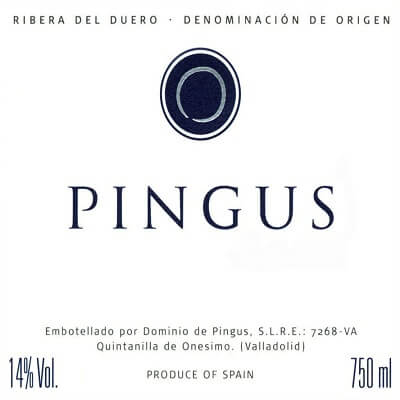 Inc. TAX€2,449.45
Inc. TAX€2,449.45 -
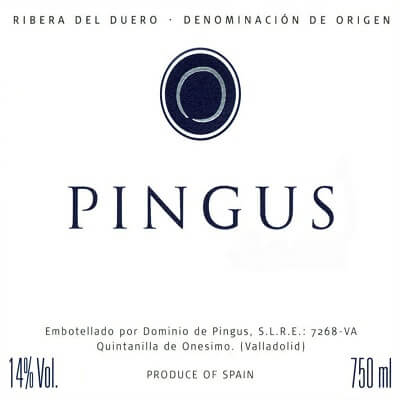
Wine Advocate (98-100)
The subtle, austere and nuanced sample of the 2021 Pingus I tasted was harmonious, balanced and elegant. It's basically pure Tempranillo from La Horra that is young but surprisingly harmonious, very precise, clean, pure, with no apparent oak despite being a barrel sample. The wine is maturing in barrels that were previously used for PSI; Sisseck purchased a couple of 1,500-liter oak vats that he's using for PSI, and he still doesn't know if he's going to age part of Pingus in it. Purity, elegance and precision. The wine is medium-bodied, the tannins super fine and the mouthfeel is velvety, with a restrained 13.8% alcohol. There should be around 8,200 bottles, and the expectation today is to bottle it around June 2023. I tasted the barrel samples from 2021, a dry year in Ribera del Duero, with a little rain in June, but it's a vintage for which Peter Sisseck felt the key was the low temperatures at night. So, 2021 is cooler than 2020; and in 2021, they harvested one week earlier than in 2020, earlier than the majority of wineries in Ribera del Duero, as he finished when the most hadn't even started. All the wines are between 13.5% and 14% alcohol (the Flor was a little higher, 14.2%, with 20% new barrels). However, Sisseck still classifies 2021 as a warm vintage, following the path of 2015 and 2016, perhaps a little more austere, perhaps the tannins are a little more noticeable and the wines are going to benefit from the élevage, for Sisseck a more classical vintage. But it's not a super warm vintage like 2009 or 2015, perhaps more in the line of the 2018 with more punch, closer to the 2016 and 2018 than 2015. But it's going to be a heterogeneous vintage in Ribera del Duero, despite what the official classification of the vintage by the appellation might have been (excellent, nonetheless!). I think the 2021s here are incredibly elegant. The first year when they harvested early was 2016, and this is the evolution within that era. In 2021, all wines, except PSI, are certified organic, and they used the new barrels that had previously been used for PSI, so no new oak in Pingus again. Amelia was fermented with 50% full clusters; it's a rare and limited wine from a single vineyard that is sold exclusively in the US. There might be a new wine in 2021, a textured red with grip and good volume, a wine with 20% Garnacha fermented with 25% full clusters. It's not clear what they are going to do with it, the result of a half hectare of five-year-old vines Sisseck planted with Tinta del País and Garnacha. There are four (used) barrels of this. Time will tell. ...Inc. TAX€2,654.98 -
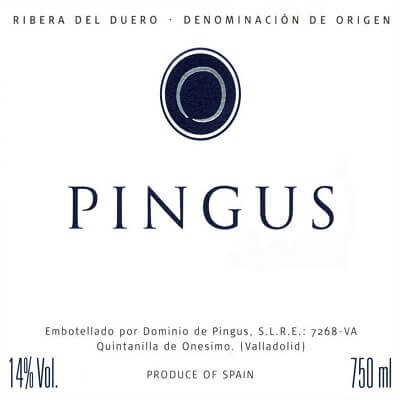
Wine Advocate (98-100)
The subtle, austere and nuanced sample of the 2021 Pingus I tasted was harmonious, balanced and elegant. It's basically pure Tempranillo from La Horra that is young but surprisingly harmonious, very precise, clean, pure, with no apparent oak despite being a barrel sample. The wine is maturing in barrels that were previously used for PSI; Sisseck purchased a couple of 1,500-liter oak vats that he's using for PSI, and he still doesn't know if he's going to age part of Pingus in it. Purity, elegance and precision. The wine is medium-bodied, the tannins super fine and the mouthfeel is velvety, with a restrained 13.8% alcohol. There should be around 8,200 bottles, and the expectation today is to bottle it around June 2023. I tasted the barrel samples from 2021, a dry year in Ribera del Duero, with a little rain in June, but it's a vintage for which Peter Sisseck felt the key was the low temperatures at night. So, 2021 is cooler than 2020; and in 2021, they harvested one week earlier than in 2020, earlier than the majority of wineries in Ribera del Duero, as he finished when the most hadn't even started. All the wines are between 13.5% and 14% alcohol (the Flor was a little higher, 14.2%, with 20% new barrels). However, Sisseck still classifies 2021 as a warm vintage, following the path of 2015 and 2016, perhaps a little more austere, perhaps the tannins are a little more noticeable and the wines are going to benefit from the élevage, for Sisseck a more classical vintage. But it's not a super warm vintage like 2009 or 2015, perhaps more in the line of the 2018 with more punch, closer to the 2016 and 2018 than 2015. But it's going to be a heterogeneous vintage in Ribera del Duero, despite what the official classification of the vintage by the appellation might have been (excellent, nonetheless!). I think the 2021s here are incredibly elegant. The first year when they harvested early was 2016, and this is the evolution within that era. In 2021, all wines, except PSI, are certified organic, and they used the new barrels that had previously been used for PSI, so no new oak in Pingus again. Amelia was fermented with 50% full clusters; it's a rare and limited wine from a single vineyard that is sold exclusively in the US. There might be a new wine in 2021, a textured red with grip and good volume, a wine with 20% Garnacha fermented with 25% full clusters. It's not clear what they are going to do with it, the result of a half hectare of five-year-old vines Sisseck planted with Tinta del País and Garnacha. There are four (used) barrels of this. Time will tell. ...Inc. TAX€3,355.45 -
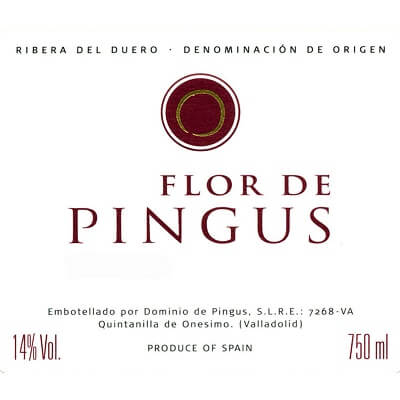
Vinous (90)
Good medium ruby. Explosive aromas of black cherry, roasted tomato, olive, game and nutty oak. Sweet, lush and gamey; a bit less densely packed than the young 2001 but still stuffed with fruit. Shows a syrah-like animal aspect.Inc. TAX€358.93 -

Vinous (93)
Inky ruby. Potent, mineral- and smoke-accented dark berry and violet scents show excellent clarity and lift. Silky and seamless in texture, offering sweet blackberry and boysenberry flavors and notes of spicecake and floral pastilles. Closes with strong thrust, appealing sweetness and sneaky, slow-mounting tannins. Very suave, even now, but this wine will be much better in another five to seven years.Inc. TAX€2,909.74 -
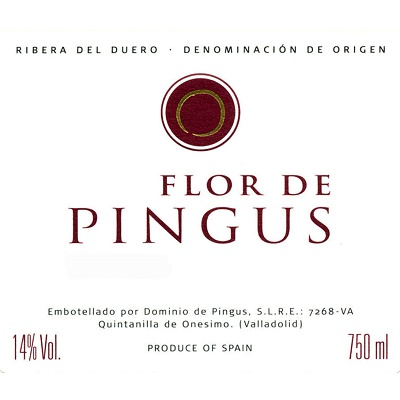
James Suckling (95)
Almost black-purple color. Dense black fruits aromas, fine oak and elegant dry tannins that are beautifuly integrated in the rich body. The long finish is already graceful thanks to the spot-on balance. Drink now.Inc. TAX€1,484.77 -
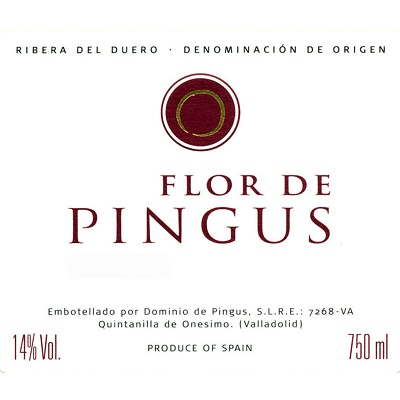
Vinous (95)
Deep violet. Smoke- and spice-accented dark berries and cherry on the highly perfumed nose. Lively bitter cherry, blueberry and violet pastille flavors stain the palate, showing fine definition and a supporting spine of tangy acidity. Opens up and deepens on the strikingly long, incisive finish, which features gently chewy tannins and lingering florality.Inc. TAX€885.18 -
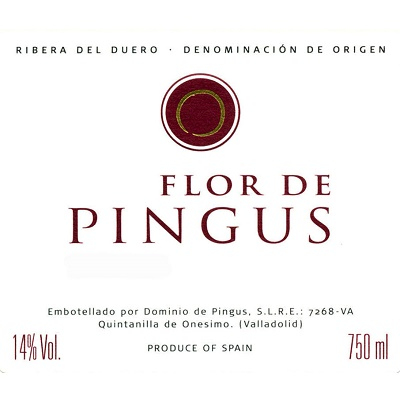
James Suckling (94-95)
A chunky and pretty young wine with blueberries and blackberries and chocolate. Chewy tannins that are polished and fresh. Full-bodied. Round and sexy. Shows lots of potential.Inc. TAX€1,043.27 -
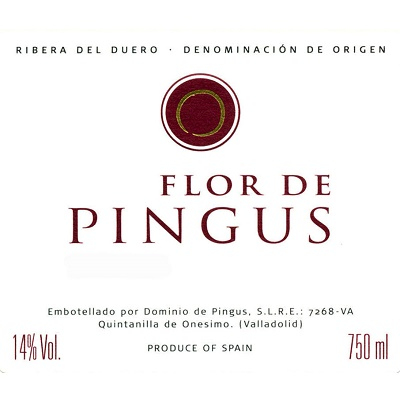
Decanter (96)
In the shadow of Pingus? Only, perhaps, if you taste it after the grand vin, because Flor de Pingus is another haute-couture masterpiece in its own right, again with that highly polished tannic texture and layers of dark but succulent and perfectly ripe mulberry fruit, suggestions of something darker and savoury emerging, but for now this is just a gloriously sensual young wine with a pronounced sense of place. Biodynamic.Inc. TAX€1,436.77 -
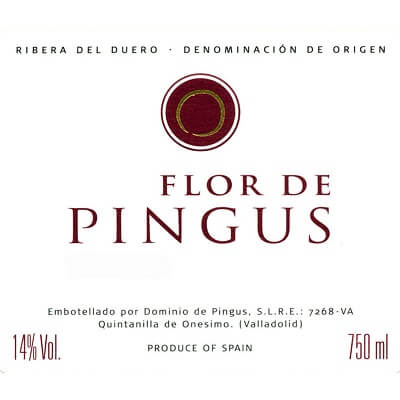
James Suckling (97)
Blackberries, black cherries and hot crushed stones with cement and black licorice. Subtle yet complex aromas. Medium to full body and an exquisite texture, with intense tannins and a long, flavorful finish. The verve and mouth-feel is luxurious and captivating. This is very structured. Try after 2024.Inc. TAX€1,604.77 -
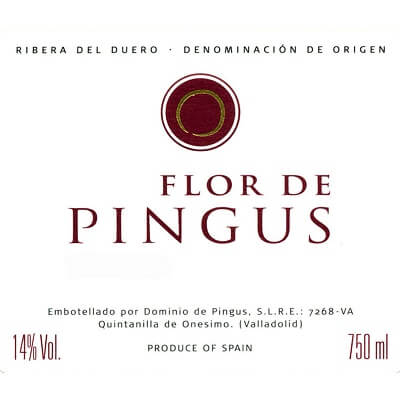 Inc. TAX€982.38
Inc. TAX€982.38 -
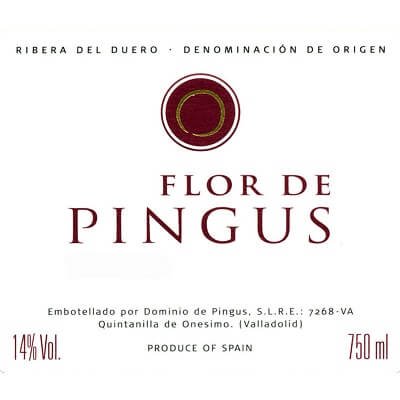 Inc. TAX€1,523.90
Inc. TAX€1,523.90 -
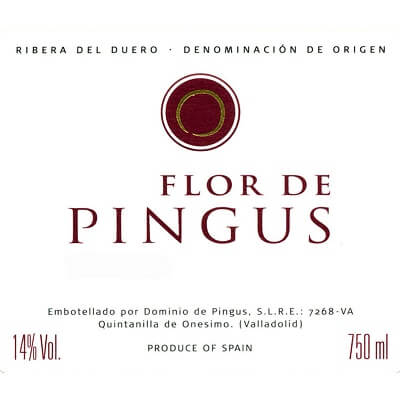 Inc. TAX€1,043.32
Inc. TAX€1,043.32 -

Introducing the Quinta Sardonia Ribera Duero 2011, a luxuriant exemplar of Spanish winemaking mastery. Quinta Sardonia, a biodynamically farmed vineyard on the limestone hillsides of Sardon de Duero, bestows us with an extraordinary red blend. Heavily influenced by the singular terroir, this Tempranillo-led blend reveals subtle suggestions of Garnacha, Cabernet Sauvignon, Malbec and Merlot, aged for 18 months in French oak barrels. The Quinta Sardonia Ribera Duero 2011 is an exquisitely balanced marriage of ripened red fruit notes, herbal nuances, and a hint of exotic spice. Its elegant minerality and firm tannin structure promise longevity, making it an admirable addition to any cellar. Could there be a more charming demonstration of Ribera Duero's capacity to yield intense, complex wines with poised sophistication? Those serious about wine will know that a bottle of Quinta Sardonia Ribera Duero 2011 is a possession of true distinction.
Inc. TAX€622.12 -
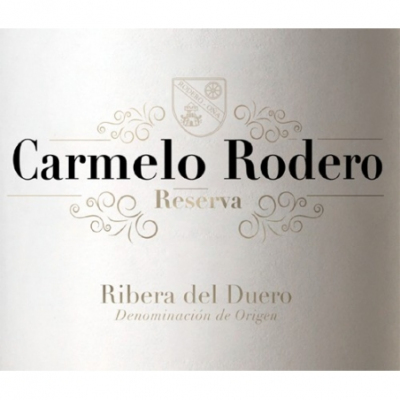
The Rodero Ribera Duero Reserva 2014 is a product of artistry and refinement, emanating from the profound greeneries of Ribera del Duero in Spain. Cultivated by the esteemed Bodegas Rodero, this Grand Reserve is an embodiment of age-old viticulture skills and state-of-the-art techniques. Matured in carefully selected French oak barrels for no less than 24 months, and rested for another 36 in the bottle, it impeccably harmonises intensity with finesse.
The Rodero Ribera Duero Reserva 2014 boasts a regal burgundy hue with purple undertones and an impressive nose showcasing blackberry, vanilla, and cocoa nuances. Its velvety palate surprise with plum, cherry and liquorice notes wonderfully balanced with soft tannins and a sustained finish. The Rodero Ribera Duero Reserva 2014 is an eloquent expression of the Tempranillo grape varietal blend and a testament to Bodegas Rodero's winemaking legacy. An elegant addition worthy of the most discerning oenophile's collection.
Inc. TAX€1,076.02 -

The acclaimed Rodero Ribera Duero Reserva 2015 is an embodiment of elegance and tradition hailing from Spain's prestigious Ribera del Duero region. Created by the family-owned Bodegas Rodero, with a winemaking reverence going back nine generations, their dedication to the land is exemplary and resonates in every vintage.
This exquisite 2015 Reserva is a blend of 75% Tempranillo and 25% Cabernet Sauvignon, aged for a minimum of 16 months in French oak barrels and an additional 36 months in bottle. The end product showcases the perfect balance of fruit and oak, encapsulating complex flavours of ripe berries, spicy oak nuances and velvety tannins with a prolonged finish.
The result of meticulous viticulture and winemaking, the Rodero Ribera Duero Reserva 2015 is a classic offering, promising both longevity and ever-growing complexity in the bottle. This vintage manifests the depth of understanding between the winegrowers and their exceptional terroir.
Inc. TAX€1,076.02 -

Wine Advocate (97)
The 2018 Matallana is the only wine they produced in Ribera del Duero, a traditional blend of Tempranillo with approximately 15% other varieties —Valenciano (Bobal), Navarro (Garnacha) and white Albillo—from different soils in five different villages, Sotillo de la Ribera, Roa, Fuentecén, Fuentemolinos and Pardilla. It fermented in oak and stainless steel vats with indigenous yeasts and matured for 14 months in French oak barrels of different ages. It has 14.5% alcohol and a pH of 3.68. The wine is subtle, harmonious and elegant, complex and with integrated oak, very expressive with velvety tannins and a long, dry, chalky finish. This is superb, elegant but with the Duero rusticity and stone minerality. It has to be the finest Matallana to date. 22,020 bottles produced. It was bottled in May and June 2020. They skipped the 2017 of this wine as the year was decimated by killer frost.Inc. TAX€928.54 -
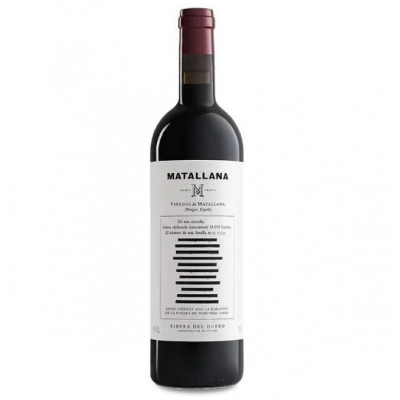
James Suckling (94)
Fresh blackberries, tangy spices and hints of graphite and oyster shell on the nose, following through to a full-bodied, juicy palate, with fine-grained, chalky tannins that dissipate into the center-palate before a long, tangy finish. Drinkable now, but best after 2024.Inc. TAX€1,071.07 -
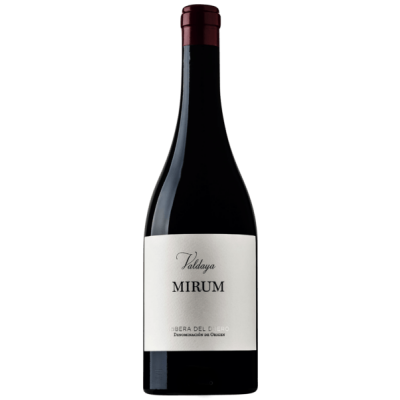
Tim Atkin MW (97)
Valdaya's top red, Mirum, keeps improving with every vintage and is now among the best wines in Ribera del Duero. Made with Tinto Fino from old-vine parcels - Los Bueyes and Las Piedras - in Baños de Valdearodos, it's very much a limestone-influenced style from 925 metres, with subtle wood, chalky minerality, red berry fruit, tension and floral, violet top notes. Long, stylish and beautifully judged. 2022-30Inc. TAX€471.18 -
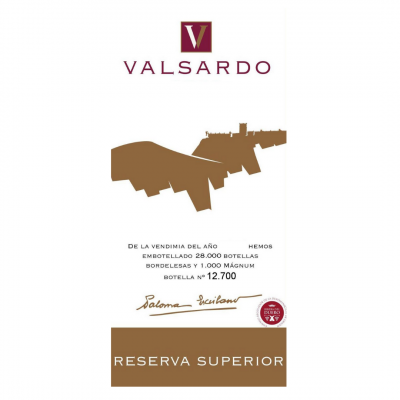 A gorgeous Tempranillo that has been left to slumber in the winery cellar for close to two decades, this ex-winery parcel of Valsardo Ribera del Duero Reserva Superior 2002 is a total no brainer. Showcasing fully integrated, soft and supple tannins, there remains plenty of lovely black fruit with classic gamey and leathery notes alongside its impeccable backbone and freshness. Made without sulphur and at only 12.5% ABV, this blend of 90% Tempranillo, with the rest Cabernet Sauvignon and Merlot, has aged amazing well.
A gorgeous Tempranillo that has been left to slumber in the winery cellar for close to two decades, this ex-winery parcel of Valsardo Ribera del Duero Reserva Superior 2002 is a total no brainer. Showcasing fully integrated, soft and supple tannins, there remains plenty of lovely black fruit with classic gamey and leathery notes alongside its impeccable backbone and freshness. Made without sulphur and at only 12.5% ABV, this blend of 90% Tempranillo, with the rest Cabernet Sauvignon and Merlot, has aged amazing well.
Sourced directly from the winery, this parcel is, in fact, a clearance sale as the winery no longer bottles under its own label, and as such they are selling off all remaining inventory. With the winery now having halted production, this is a piece of Ribera del Duero history.Inc. TAX€232.38
-

Wine Advocate (94+)
The youngest of the reds I tasted, the 2019 Pícaro del Águila Tinto is their most approachable red and is still serious, vibrant and aromatic with great length and still has good aging potential. They use the grapes from the warmest vineyards they have in the village of La Aguilera, form the northern part closer to La Horra, mostly Tempranillo but with some 5% of other varieties (red and white) interplanted in the old vineyards, fermented together with full clusters and indigenous yeasts and matured in French oak barrels for 15 months. Like the 2019 Clarete, this is young and tender and has more tension than I expected for a warmer year. It has less oak than previous years (only 10% or 15% new barrels), and the wine feels better balanced and is floral and aromatic. It's medium-bodied with a very fine texture, a pretty wine that drinks very well and doesn't reflect a warm year at all, as it has incredible freshness. A great Pícaro. They produced 69,852 bottles and 850 magnums, a notable increase in volume... while they increase the quality! It was bottled in February 2021.In Bond€285.00 -

Wine Advocate (95)
The juicy, velvety and aromatic red 2020 Pícaro del Águila Tinto is fine-boned and quite faithfully represents what they want to express with this cuvée; it's very tasty and has some chalkiness (perhaps through less ripeness than in years like 2018) with 14% alcohol and mellow acidity. The nose reveals some Côte-Rôtie-like notes of smoked meat and violets. 2020 delivered a good crop of healthy grapes that produced the finest wine to date for this bottling. This is superb, elegant and powerful, with everything in place (seems to be the signature of 2020) and perfectly integrated oak. 71,382 bottles and 1,979 magnums produced. It was bottled in September 2021.In Bond€326.00 -
 In Bond€286.00
In Bond€286.00 -

Vinous (95)
Deep, bright ruby-red. Cherry, licorice and smoked meat at the outset; then exploded with raspberry fruit. Lush, smooth and silky, with lovely inner-mouth perfume. Highly complex flavors of raspberry, minerals, bitter chocolate and smoky oak convey an extraordinary sweetness without any excess weight. Expands wonderfully on the extremely long, aromatic finish, which features noble, palate-dusting tannins. From the recorked bottle, the wine again began with dominant smoky, tarry torrefaction notes, and within minutes was taken over by red berries and flowers. More classic than the '03, but the 2003 may be even richer.In Bond€3,620.00 -

Wine Advocate (98)
The 2006 Pingus is a spectacular effort. A glass-staining saturated opaque purple, it delivers an other-worldly perfume of smoke, lavender, mineral, scorched earth, and an amalgam of kinky black fruits. Voluptuous on the palate in a measured way, it has superb balance, layered, complex flavors, ripe tannin that is entirely covered by the fruit, and a decade of aging potential. This monumental wine will evolve effortlessly for 10-15 years and offer a drinking window extending from 2016 to 2036.In Bond€9,665.00 -

Wine Advocate (96)
I tasted the 2013 Pingus one week before the wine was to be bottled, but one never knows. I tasted the 2012 under the same circumstances last year, and after my tasting, Peter Sisseck decided the wine needed some more time, so the élevage was extended and the bottling delayed. I was told this should be very close to the bottled version. The nose is aromatic, expressive and open, quite perfumed and subtle, with no traces of oak (the wine now ages in used barriques); even the spices are very much in the background. The Pingus vineyards behaved quite well in a difficult vintage, as great vineyards are a lot more homogeneous, so the vines are very balanced: the two vineyards used for Pingus, San Cristobal and Barroso, were planted in 1929 with two different massale selections. The palate is also approachable and gentle, with very good acidity and very fine tannins, elegance and character. I think there will be very few (or none!) wines in Ribera in 2013 like this Pingus. Well done! Three weeks later, I received an email letting me know that the wine had been bottled, so I proceeded to taste the bottle version, which showed what the sample promised. 2013 will be a vintage, that in Ribera del Duero, will show the differences of the work in the vineyards and what they do at Pingus clearly paid off. Even after the recent operation, the wine is harmonious and feels very balanced; there is no dizziness and it keeps the poise. A real triumph for the vintage. 6,600 bottles were filled at the end of July 2015.In Bond€1,450.00 -

Wine Advocate (100)
I don't think I've ever tasted a wine more recently bottled than the 2014 Pingus, which was bottled in the morning and I tasted it that very same evening! Peter Sisseck compares this to the 1995, the first vintage ever produced, when he learned that when you have such perfect grapes, you should do very little to the wine. He's been trying to replicate that first vintage, but there's nothing you can do to force it, as it has to be the natural conditions of the vintage that bring those grapes. What he also learned with the 1995 was that with wines like that, you need a long and slow aging in oak; so for the 2014, he decided to do a little longer élevage—three winters in barrel—but in 100% used barrels, something he started in 2012. If it would have been new oak, as in the past, it would have been impossible to have such extended aging without marking the wine too much and possibly forever. The wine was quite tannic to start with, but it was racked every six months, and in that way they have managed to tame those tannins without getting the wine tired, as the aging itself was quite reductive. The nose is quite harmonious and open, but maybe not very expressive, a normal thing considering the extremely short bottle age it had (hours!), but it should gain precision in bottle. In instances like this, you have to guide yourself by the palate. And it's precisely on the palate where you find that texture that is almost unique to Ribera del Duero when it's as perfect as this. It's very different from other zones, a velvety mouthfeel and a surrounding sensation of comfort, incredibly long. The tannins are ultra fine and with that subtle chalkiness of the limestone soils, which also added to the tastiness and the supple aftertaste. In short, I cannot think of a way of improving this Pingus other, than getting a magnum instead of a regular bottle! Congratulations, Peter Sisseck! 4,800 bottles were filled on January 16th of 2017, a slightly shorter production than the average, because part of the vines were hit by hail and didn't make it into the final blend. Now stay tuned for 2015 and 2016.In Bond€7,260.00 -

Wine Advocate (99)
Peter Sisseck was ecstatic about the quality of the 2015 Pingus. Since he no longer uses any new oak—and hasn't since 2012—the élevage in used wood is extended to 23 or 24 months. This is the first vintage certified as biodynamic from Demeter. We poured the wine and took half an hour to get to it, as the wine was very closed at first and opened up very slowly in the glass. Little by little, the nose started showing a floral character, what I consider the perfume of great Ribera del Duero, the elegant part that compensates the powerful nature of the wines and gives the finesse to the best wines. The wine has been very consistent in the last few vintages, as Sisseck reckons the old but balanced vines (they started working in biodynamics in 2000) cushion the vintage differences more than other younger vineyards. These vines were planted in 1929, and they have always been farmed organically and in a traditional way. This is truly outstanding. In a way, it made me think of 2010, even if they are very different years. It was bottled in August 2017, and there are some 6,500 bottles of this gem. Even if very young, it already drinks well. Great wines tend to be drinkable throughout their life...In Bond€5,420.00 -

Wine Advocate (100)
I was really looking forward to the bottled version of the 2018 Pingus after a great showing of the cask sample last year. Part of the wine matured in 20,000-liter oak casks, so it's not all barrique. This is the first time they used the vats, and based on the results, Sisseck thinks in the future Pingus will be around 50% in oak vats. The Pingus vines were planted in 1929 in two different sectors of the village of La Horra, Barroso and San Cristobal and contain some 2% other varieties. The vineyards are certified organic and biodynamic and are manicured like few vineyards in Spain. The wine is subtle and harmonious, elegant and insinuating, with all the components in very good balance. This is precise and pure; Sisseck is thorough and meticulous, and the wine shows that precision. This follows the line of the 2016, showing very well even if it was bottled only one month before I tasted it. 9,300 bottles were filled in August 2020.In Bond€2,340.00 -

Wine Advocate (100)
I was really looking forward to the bottled version of the 2018 Pingus after a great showing of the cask sample last year. Part of the wine matured in 20,000-liter oak casks, so it's not all barrique. This is the first time they used the vats, and based on the results, Sisseck thinks in the future Pingus will be around 50% in oak vats. The Pingus vines were planted in 1929 in two different sectors of the village of La Horra, Barroso and San Cristobal and contain some 2% other varieties. The vineyards are certified organic and biodynamic and are manicured like few vineyards in Spain. The wine is subtle and harmonious, elegant and insinuating, with all the components in very good balance. This is precise and pure; Sisseck is thorough and meticulous, and the wine shows that precision. This follows the line of the 2016, showing very well even if it was bottled only one month before I tasted it. 9,300 bottles were filled in August 2020.In Bond€5,600.00 -
 In Bond€2,035.00
In Bond€2,035.00 -

Wine Advocate (98-100)
The subtle, austere and nuanced sample of the 2021 Pingus I tasted was harmonious, balanced and elegant. It's basically pure Tempranillo from La Horra that is young but surprisingly harmonious, very precise, clean, pure, with no apparent oak despite being a barrel sample. The wine is maturing in barrels that were previously used for PSI; Sisseck purchased a couple of 1,500-liter oak vats that he's using for PSI, and he still doesn't know if he's going to age part of Pingus in it. Purity, elegance and precision. The wine is medium-bodied, the tannins super fine and the mouthfeel is velvety, with a restrained 13.8% alcohol. There should be around 8,200 bottles, and the expectation today is to bottle it around June 2023. I tasted the barrel samples from 2021, a dry year in Ribera del Duero, with a little rain in June, but it's a vintage for which Peter Sisseck felt the key was the low temperatures at night. So, 2021 is cooler than 2020; and in 2021, they harvested one week earlier than in 2020, earlier than the majority of wineries in Ribera del Duero, as he finished when the most hadn't even started. All the wines are between 13.5% and 14% alcohol (the Flor was a little higher, 14.2%, with 20% new barrels). However, Sisseck still classifies 2021 as a warm vintage, following the path of 2015 and 2016, perhaps a little more austere, perhaps the tannins are a little more noticeable and the wines are going to benefit from the élevage, for Sisseck a more classical vintage. But it's not a super warm vintage like 2009 or 2015, perhaps more in the line of the 2018 with more punch, closer to the 2016 and 2018 than 2015. But it's going to be a heterogeneous vintage in Ribera del Duero, despite what the official classification of the vintage by the appellation might have been (excellent, nonetheless!). I think the 2021s here are incredibly elegant. The first year when they harvested early was 2016, and this is the evolution within that era. In 2021, all wines, except PSI, are certified organic, and they used the new barrels that had previously been used for PSI, so no new oak in Pingus again. Amelia was fermented with 50% full clusters; it's a rare and limited wine from a single vineyard that is sold exclusively in the US. There might be a new wine in 2021, a textured red with grip and good volume, a wine with 20% Garnacha fermented with 25% full clusters. It's not clear what they are going to do with it, the result of a half hectare of five-year-old vines Sisseck planted with Tinta del País and Garnacha. There are four (used) barrels of this. Time will tell. ...In Bond€2,205.00 -

Wine Advocate (98-100)
The subtle, austere and nuanced sample of the 2021 Pingus I tasted was harmonious, balanced and elegant. It's basically pure Tempranillo from La Horra that is young but surprisingly harmonious, very precise, clean, pure, with no apparent oak despite being a barrel sample. The wine is maturing in barrels that were previously used for PSI; Sisseck purchased a couple of 1,500-liter oak vats that he's using for PSI, and he still doesn't know if he's going to age part of Pingus in it. Purity, elegance and precision. The wine is medium-bodied, the tannins super fine and the mouthfeel is velvety, with a restrained 13.8% alcohol. There should be around 8,200 bottles, and the expectation today is to bottle it around June 2023. I tasted the barrel samples from 2021, a dry year in Ribera del Duero, with a little rain in June, but it's a vintage for which Peter Sisseck felt the key was the low temperatures at night. So, 2021 is cooler than 2020; and in 2021, they harvested one week earlier than in 2020, earlier than the majority of wineries in Ribera del Duero, as he finished when the most hadn't even started. All the wines are between 13.5% and 14% alcohol (the Flor was a little higher, 14.2%, with 20% new barrels). However, Sisseck still classifies 2021 as a warm vintage, following the path of 2015 and 2016, perhaps a little more austere, perhaps the tannins are a little more noticeable and the wines are going to benefit from the élevage, for Sisseck a more classical vintage. But it's not a super warm vintage like 2009 or 2015, perhaps more in the line of the 2018 with more punch, closer to the 2016 and 2018 than 2015. But it's going to be a heterogeneous vintage in Ribera del Duero, despite what the official classification of the vintage by the appellation might have been (excellent, nonetheless!). I think the 2021s here are incredibly elegant. The first year when they harvested early was 2016, and this is the evolution within that era. In 2021, all wines, except PSI, are certified organic, and they used the new barrels that had previously been used for PSI, so no new oak in Pingus again. Amelia was fermented with 50% full clusters; it's a rare and limited wine from a single vineyard that is sold exclusively in the US. There might be a new wine in 2021, a textured red with grip and good volume, a wine with 20% Garnacha fermented with 25% full clusters. It's not clear what they are going to do with it, the result of a half hectare of five-year-old vines Sisseck planted with Tinta del País and Garnacha. There are four (used) barrels of this. Time will tell. ...In Bond€2,785.00 -

Vinous (90)
Good medium ruby. Explosive aromas of black cherry, roasted tomato, olive, game and nutty oak. Sweet, lush and gamey; a bit less densely packed than the young 2001 but still stuffed with fruit. Shows a syrah-like animal aspect.In Bond€296.00 -

Vinous (93)
Inky ruby. Potent, mineral- and smoke-accented dark berry and violet scents show excellent clarity and lift. Silky and seamless in texture, offering sweet blackberry and boysenberry flavors and notes of spicecake and floral pastilles. Closes with strong thrust, appealing sweetness and sneaky, slow-mounting tannins. Very suave, even now, but this wine will be much better in another five to seven years.In Bond€2,380.00 -

James Suckling (95)
Almost black-purple color. Dense black fruits aromas, fine oak and elegant dry tannins that are beautifuly integrated in the rich body. The long finish is already graceful thanks to the spot-on balance. Drink now.In Bond€1,200.00 -

Vinous (95)
Deep violet. Smoke- and spice-accented dark berries and cherry on the highly perfumed nose. Lively bitter cherry, blueberry and violet pastille flavors stain the palate, showing fine definition and a supporting spine of tangy acidity. Opens up and deepens on the strikingly long, incisive finish, which features gently chewy tannins and lingering florality.In Bond€719.00 -

James Suckling (94-95)
A chunky and pretty young wine with blueberries and blackberries and chocolate. Chewy tannins that are polished and fresh. Full-bodied. Round and sexy. Shows lots of potential.In Bond€847.00 -

Decanter (96)
In the shadow of Pingus? Only, perhaps, if you taste it after the grand vin, because Flor de Pingus is another haute-couture masterpiece in its own right, again with that highly polished tannic texture and layers of dark but succulent and perfectly ripe mulberry fruit, suggestions of something darker and savoury emerging, but for now this is just a gloriously sensual young wine with a pronounced sense of place. Biodynamic.In Bond€1,160.00 -

James Suckling (97)
Blackberries, black cherries and hot crushed stones with cement and black licorice. Subtle yet complex aromas. Medium to full body and an exquisite texture, with intense tannins and a long, flavorful finish. The verve and mouth-feel is luxurious and captivating. This is very structured. Try after 2024.In Bond€1,300.00 -
 In Bond€800.00
In Bond€800.00 -
 In Bond€1,225.00
In Bond€1,225.00 -
 In Bond€847.00
In Bond€847.00 -

Introducing the Quinta Sardonia Ribera Duero 2011, a luxuriant exemplar of Spanish winemaking mastery. Quinta Sardonia, a biodynamically farmed vineyard on the limestone hillsides of Sardon de Duero, bestows us with an extraordinary red blend. Heavily influenced by the singular terroir, this Tempranillo-led blend reveals subtle suggestions of Garnacha, Cabernet Sauvignon, Malbec and Merlot, aged for 18 months in French oak barrels. The Quinta Sardonia Ribera Duero 2011 is an exquisitely balanced marriage of ripened red fruit notes, herbal nuances, and a hint of exotic spice. Its elegant minerality and firm tannin structure promise longevity, making it an admirable addition to any cellar. Could there be a more charming demonstration of Ribera Duero's capacity to yield intense, complex wines with poised sophistication? Those serious about wine will know that a bottle of Quinta Sardonia Ribera Duero 2011 is a possession of true distinction.
In Bond€496.00 -

The Rodero Ribera Duero Reserva 2014 is a product of artistry and refinement, emanating from the profound greeneries of Ribera del Duero in Spain. Cultivated by the esteemed Bodegas Rodero, this Grand Reserve is an embodiment of age-old viticulture skills and state-of-the-art techniques. Matured in carefully selected French oak barrels for no less than 24 months, and rested for another 36 in the bottle, it impeccably harmonises intensity with finesse.
The Rodero Ribera Duero Reserva 2014 boasts a regal burgundy hue with purple undertones and an impressive nose showcasing blackberry, vanilla, and cocoa nuances. Its velvety palate surprise with plum, cherry and liquorice notes wonderfully balanced with soft tannins and a sustained finish. The Rodero Ribera Duero Reserva 2014 is an eloquent expression of the Tempranillo grape varietal blend and a testament to Bodegas Rodero's winemaking legacy. An elegant addition worthy of the most discerning oenophile's collection.
In Bond€878.00 -

The acclaimed Rodero Ribera Duero Reserva 2015 is an embodiment of elegance and tradition hailing from Spain's prestigious Ribera del Duero region. Created by the family-owned Bodegas Rodero, with a winemaking reverence going back nine generations, their dedication to the land is exemplary and resonates in every vintage.
This exquisite 2015 Reserva is a blend of 75% Tempranillo and 25% Cabernet Sauvignon, aged for a minimum of 16 months in French oak barrels and an additional 36 months in bottle. The end product showcases the perfect balance of fruit and oak, encapsulating complex flavours of ripe berries, spicy oak nuances and velvety tannins with a prolonged finish.
The result of meticulous viticulture and winemaking, the Rodero Ribera Duero Reserva 2015 is a classic offering, promising both longevity and ever-growing complexity in the bottle. This vintage manifests the depth of understanding between the winegrowers and their exceptional terroir.
In Bond€878.00 -

Wine Advocate (97)
The 2018 Matallana is the only wine they produced in Ribera del Duero, a traditional blend of Tempranillo with approximately 15% other varieties —Valenciano (Bobal), Navarro (Garnacha) and white Albillo—from different soils in five different villages, Sotillo de la Ribera, Roa, Fuentecén, Fuentemolinos and Pardilla. It fermented in oak and stainless steel vats with indigenous yeasts and matured for 14 months in French oak barrels of different ages. It has 14.5% alcohol and a pH of 3.68. The wine is subtle, harmonious and elegant, complex and with integrated oak, very expressive with velvety tannins and a long, dry, chalky finish. This is superb, elegant but with the Duero rusticity and stone minerality. It has to be the finest Matallana to date. 22,020 bottles produced. It was bottled in May and June 2020. They skipped the 2017 of this wine as the year was decimated by killer frost.In Bond€729.00 -

James Suckling (94)
Fresh blackberries, tangy spices and hints of graphite and oyster shell on the nose, following through to a full-bodied, juicy palate, with fine-grained, chalky tannins that dissipate into the center-palate before a long, tangy finish. Drinkable now, but best after 2024.In Bond€855.00 -

Tim Atkin MW (97)
Valdaya's top red, Mirum, keeps improving with every vintage and is now among the best wines in Ribera del Duero. Made with Tinto Fino from old-vine parcels - Los Bueyes and Las Piedras - in Baños de Valdearodos, it's very much a limestone-influenced style from 925 metres, with subtle wood, chalky minerality, red berry fruit, tension and floral, violet top notes. Long, stylish and beautifully judged. 2022-30In Bond€374.00 -
 A gorgeous Tempranillo that has been left to slumber in the winery cellar for close to two decades, this ex-winery parcel of Valsardo Ribera del Duero Reserva Superior 2002 is a total no brainer. Showcasing fully integrated, soft and supple tannins, there remains plenty of lovely black fruit with classic gamey and leathery notes alongside its impeccable backbone and freshness. Made without sulphur and at only 12.5% ABV, this blend of 90% Tempranillo, with the rest Cabernet Sauvignon and Merlot, has aged amazing well.
A gorgeous Tempranillo that has been left to slumber in the winery cellar for close to two decades, this ex-winery parcel of Valsardo Ribera del Duero Reserva Superior 2002 is a total no brainer. Showcasing fully integrated, soft and supple tannins, there remains plenty of lovely black fruit with classic gamey and leathery notes alongside its impeccable backbone and freshness. Made without sulphur and at only 12.5% ABV, this blend of 90% Tempranillo, with the rest Cabernet Sauvignon and Merlot, has aged amazing well.
Sourced directly from the winery, this parcel is, in fact, a clearance sale as the winery no longer bottles under its own label, and as such they are selling off all remaining inventory. With the winery now having halted production, this is a piece of Ribera del Duero history.In Bond€175.00





















